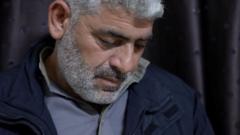The ongoing fallout from Syria's civil war poses life-threatening challenges to returning families, as they confront the dangers presented by landmines and unexploded ordnance (UXOs). Ayghad, a fatherless farmer in Idlib province, represents many who yearn to reclaim their land but are met with a stark reality of menace and loss.
Five years ago, Ayghad and his father were forced to leave their home due to escalating violence from government forces against rebel-held territories, specifically in the city of Saraqeb, which was vital to the opposition's efforts. Their return was eagerly anticipated when opposition forces regained control over their village in late 2024, but the dream was shattered when Ayghad's father tragically died from a landmine explosion as they attempted to harvest olives.
The grim statistics reported by the Halo Trust reveal a chilling trend: at least 144 deaths, including 27 children, have been linked to landmines since the regime's collapse. Many of these fatalities occurred among farmers and landowners returning to their former farmlands, where remnants of war lay hidden and lethal.
The risks associated with these explosive remnants fall into two main categories: the more visible UXOs like cluster bombs and mortars are easier to clear, while landmines planted by former government forces present a much more significant challenge. Efforts led by the White Helmets have focused on safely identifying and cordoning off minefields, but the scale of the issue continues to grow with an estimation that over a million devices require destruction to safeguard civilian lives.
The lack of coordination among international organizations tackling this complex issue exacerbates the problem. Organizations such as Halo Trust acknowledge the necessity for a comprehensive survey of contaminated areas to better understand and combat the scale of the landmine crisis.
Recent discoveries of maps left behind by government forces have improved hopes for more efficient clearing, but local expertise and resources remain severely lacking. Humanitarian experts emphasize that without significant international support—both financial and technical—the urgency to enhance local capacities will remain unmet.
As local farmers, like Mohammed, grapple with the devastating economic impacts of land that can no longer be cultivated due to lurking dangers, the personal stakes intensify. The ongoing risks faced by civilians, particularly children, underscore the pressing need for coordinated efforts to neutralize these threats and demystify their haunting presence in Syria's recovery narrative.


















